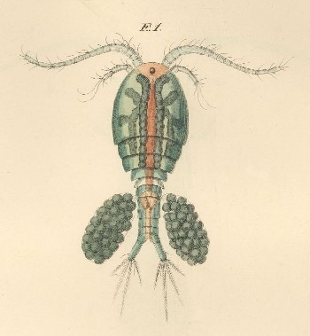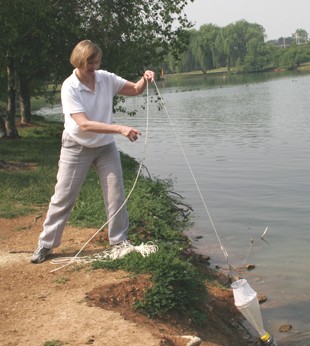Evolution in progress
News
By Eric Gorton, JMU Media Relations
The saying goes something like this: If it walks like a duck, quacks like a duck, looks like a duck, then it must be a duck.
Well, that may work for identifying the genus, but what species of duck is it and how did it get to be that kind of duck? The simple answer is: The duck is the same as its parents.
In the world of copepods — where evolution occurs in real time, so to speak — that type of reasoning doesn't always work.
"Some identically appearing forms collected from the same pond cannot mate and produce young, thus defining them as different species," says James Madison University biology Professor Grace Wyngaard, whose research on copepod development landed in the pages of the journal Evolution in March.
So what's so special about a speck of a species at the low end of the food chain? It seems this tiny crustacean, the main diet for many of the world's fish, might reveal some big clues about the evolution of species.
Sam Scheiner, program director in the National Science Foundation's Division of Environmental Biology, which funded the research of Wyngaard and three colleagues (at the Russian Academy of Sciences, East Tennessee State University and the University of Wisconsin-Madison), said the study "provides critical evidence that the ways species form and evolve are more complicated than we had previously understood."
Unlike humans, some copepod species are able to genetically alter themselves to adapt to their environment, Wyngaard said. For instance, copepods living in waters that are low on food and also low on predators can stunt their growth rate by slowing their cell-division rate during the embryonic stage. This enables them to grow larger and also gives their young a better chance at survival. Other copepods of the same species but living among lots of copecod-consuming fish, meanwhile, need to develop more rapidly because it's important to get to reproduction before they are eaten.
"These animals have a very unusual phenomenon where, when they're embryos, they chop up their chromosomes, throw out anywhere from 30 to 95 percent of their DNA, glue their chromosomes back together and go on with life. And they do this in all of the cells that are going to become somatic cells: intestine, eye, muscle, nerve, all those. It's very different from humans," Wyngaard said.

Even dramatic evolutionary changes can occur from one generation to the next. In fact, the offspring from one pair of copepods could be the beginnings of two new species — different from the parents as well as from each other.
During the embryonic stage, Wyngaard explained, the chromosomes — the structural carrier of hereditary characteristics found in the nucleus of every cell — fragment and then re-form, but not always into the original positions. "Think of chopping up six or eight pieces of thread and then gluing some of the pieces back together. The result can be six, seven, eight, nine or 10 threads, or chromosomes. Most animals can't tolerate this, but there is something about the Acanthocyclops vernalis genome that can, to a degree.
"Many of the embryos don't survive, but some do and are very hardy. Some embryos will be missing a critical part, some will have too much of a certain part, or gene, and maybe some will just have a new order of genes."
As the lines continue to change, the animals develop differences in mating behavior, genitalia that won't fit together and even different preferences for habitat — and thus, new species may be created.
So why all this change?
"I think that the changes we witness in the copepods occur randomly," Wyngaard said. "The copepods are not striving to change or improve, but these chromosomal changes may enable them to adapt rapidly to changing environments. It may explain why this species complex is the hardiest and most widespread copepod in North America."
Still, there is much to learn about their evolution and several challenges.
"One problem with copepods is that there are only three known fossils. And we don't know the rates at which certain genes evolve in copepods, and other crustaceans, for that matter. For some organisms, such as vertebrates, we can use the molecular clock to measure rates of change and evolution. We are beginning to find out that this method is not reliable for crustaceans."
Wyngaard is determined to continue plugging away at the mysteries. During more than 30 years of research, she has learned patience has its rewards.
"My research strategy is to mull over questions and wait for the right technique to be developed that can address that question, and then to pounce on it," she said. "Sometimes I have to wait years, or decades, but it is worth the wait. I am in this for the long haul. And, as I tell my students, 'sometimes science moves slowly and one has to be very patient.'"

